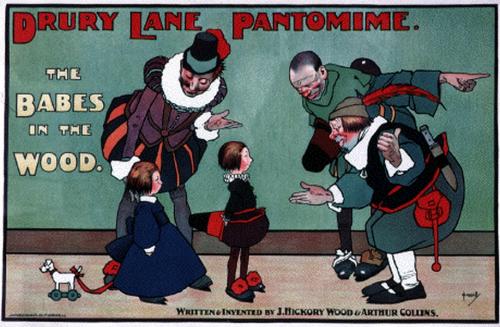My research of nineteenth-century in theatre companies in Entrepreneurs, Empires and Pantomimes revealed to me how theatre industries offered more than just a patriarchal view of the ‘great man’ or the ‘captain of industry’ narrative. Through its ‘gig economy’ of short term contracts and transitory lifestyle, every member of the company had to be entrepreneurial, not just its manager. In any case, managers were predominantly artist, as many theatre historians have shown via histories of the actor-manager like Henry Irving.
However, there was also the phenomenon of husband and wife managers/star actor teams likes Squire Bancroft and Effie Bancroft in the UK, Alfred Dampier and Katherine Russell, J. C. Williamson and Maggie Moore and many more. While, historically speaking, the ‘star system’ had developed to bring more certainty and status to what began in English culture as a profession once thought of as ‘rogues and vagabonds’, theatre historians like Kathleen McGill show how the influence of the husband and wife partnerships of the Italian Commedia dell’Arte greatly influenced English theatre practices.
Italian companies had a direct impact on English theatre as the expulsion of Commedia troupes from Italy continued, thanks to the persecution by popes and bishops. Most arrived in England via France. Hogarth’s 1734 engraving of the Southwark Fair, for instance, shows Commedia dell’Arte performers were clearly visible.

The growth of English pantomime is very well documented through the histories of John Rich at the Lincoln’s Inn Theatre, from which the term ‘pantomime’ appeared on a London playbill for The Loves of Mars and Venus in 1717. Rich’s creation of the harlequin character ‘Lun’ was performed in pantomimes in the Theatre Royal Covent Garden and the Little Theatre, Haymarket (an early version of the Theatre Royal Haymarket). The new form was soon taken up by the Theatre Royal Drury Lane, not least because of the presence of Italian companies in the same locations (Viola Papetti (2002) Arlecchino A Londra: La Pantomima Inglese 1700 – 1728)
The popularity of the form grew in tandem with the Victorian invention of the Christmas Holiday Festival. To this end, David Mayer (1969) argues that the Christmas pantomime festival came after 1848, some 131 years after Rich introduced the form. Previously, Mayer explains, theatre-goers participated in four wholly distinct pantomime seasons. It is no coincidence then that pantomimes came to be ‘traditionally’ opened on Boxing Day, another Victorian innovation, thanks to the enterprising Prince Albert, consort of Queen Victoria. The day’s ‘Saturnalian’ connections were clearly acknowledged in the nineteenth century.
Boxing Day, said The Times in 1871, was ‘the Saturnalia of our people, secured to it now by Act of Parliament.’ It was devoted to parties and merriment which among the lower orders degenerated into drunken disorders that shocked the respectable, strained the patience of the police, and were dealt with compassionately by the magistrates on 27th December. Meanwhile Christmas Day itself grew in importance as compared with the rest of the Twelve Days. The main reason was that it was the focus of the family celebrations and increasingly of most of the traditional ritual. It had a sacramental quality which none of the others shared. But stamina and financial stress also entered in. ‘Christmas Eve, Christmas Day, and St. Stephen’s or Boxing Day’, wrote Chambers in the Book of Days in 1868, ‘has absorbed almost entirely the tendencies and opportunities of the community at large in the direction of joviality and relaxation.’ ‘In spite of January 1st,’ said a French observer, the journalist and radical politician Alphonse Esquiros, in 1861, 26th December was ‘the English anniversary’ (96).
With this context and influence in mind, the growth of the pantomime’s popularity coincided with the growth of London’s West End theatre district as well as Fleet Street’s newspaper district. At a time of such extraordinary economic change, it was the artists’ and managers’ entrepreneurial skills that enabled them to grasp opportunities through the new theatre regulations of 1843 which allow many theatres to gain a licence, in contrast to the restricted licences of post-Restoration days.
The idea of a regular pantomime season made huge economic sense and the theatre managers themselves began to ‘quality control’ their production through directing and devising the production. In turn, managers provided work for thousands of performers all around the English-speaking world, spurred on by spectacular stage technology that created stunning special effects involving staging lighting, mechanical effects which used water, fire, flying effects through pulleys and gauzy transparent stage flats.
The ‘book of works’ of these pantomimes can now be accessed from national and state archives as part of the Creative Commons of texts, both in print or digitised form.


Why start in ‘the past’?
Historians speak of historical stories as living in the eternal present. That’s because remembering is a creative process that serves to answer questions and issues in the immediate contexts in which we live.
It means that we never create new ideas or enact solutions in a vacuum. Memories of what we have done in the past or learning about what others may have done ‘way back when’ are designed to get us to plan what we should do.
The work of theatre companies that produced pantomime through entrepreneurial skills should be likened to watching entrepreneurs at work. Through their examples, we can kick off our own work, following, adapting or discarding their examples.